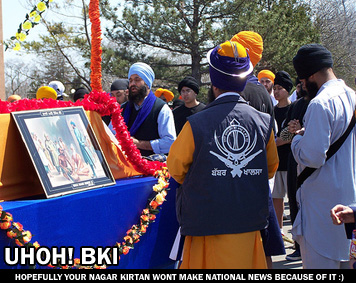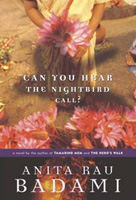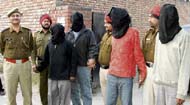
Recently on “The Langar Hall” there has been discussion about “Runaway Grooms” who with their immigration status abroad marry women from Punjab, only to abandon them after receiving the dowry. Along with being deserted by their husbands, these women’s “dreams” of going abroad are also shattered. These “dreams” were generally a primary reason many of the women were married to these men. Hasit Shah writes in his BBC news article,
“You can see it around you. There is a lot of foreign money in this city [Jalandhar]. The NRIs have been coming back and building huge houses and flaunting their success. The locals see this and want a better life for their daughters, but when the husband is unscrupulous, the women’s lives are ruined.”
Many Punjabi men in Punjab/India are also tremendously influenced by this wealth and have dreams of going abroad (a lot of it has to do with lack of job/economic opportunities in Punjab). NRI women’s green cards and citizenship status become routes for gaining permanent residency abroad. Interestingly, it is the “unscrupulousness” behavior of “husbands” and gendered power dynamics prevalent in “Runaway Groom” situations that translate into the predicaments faced by a growing number of NRI women who are also manipulated and abused by their Punjabi Sikh husbands from Punjab/India. Their “husbands” were not interested in a marriage … they really only wanted the money and permanent residency abroad. I completely agree that this is not the outcome of all NRI and non-NRI marriages. Many couples are very happy. Yes, I acknowledge that the circumstances are different for NRI and non-NRI women based on the power hierarchy between the
Last week, an article appeared in the Toronto Star by a young university student, Jasmeet Sidhu. In the article Jasmeet discusses her [is this gender assumptions or what, the name given is only Jasmeet Sidhu and nowhere in the article does it state whether she is male or female, but I am assuming female based on her music tastes] problems with living the life of a “bicultural suburban teen.” Now this topic is hardly new to the The Langar Hall. In fact in some ways, it has been discussed here in various manifestations many many many times.
problems with living the life of a “bicultural suburban teen.” Now this topic is hardly new to the The Langar Hall. In fact in some ways, it has been discussed here in various manifestations many many many times.
Jasmeet’s case seems to follow a similar story. Tired of the what she feels is the hypocrisy of her own community, she is attracted by the lures of greater Canadian society. [An interesting assumption here is that Punjabi-Canadian society can never be considered ‘Canadian’ despite the huge presence, influence, and cross-cultural encounters that have spanned for more than a century.]
For Jasmeet and for many others, the world seems only binaries:
Bhangra or Rihanna? Arranged or “love” marriages?
The Broadcast Piece:
Last week Radio 4 on the BBC broadcasted a piece titled “Sikh Terror – the UK Connection.” The piece was produced by Amardeep Bassey as an investigation into possible terror links within the UK Sikh community. You can download the 40 minute report by clicking here.
 Despite other bloggers believing that criticism of the piece by Bassey somehow emboldens the enemies, my feeling is that is as stupid as saying “You’re with us or with the terrorists.” However, those that cannot begin the process of internal discussion within the community are guilty of the same stupidity.
Despite other bloggers believing that criticism of the piece by Bassey somehow emboldens the enemies, my feeling is that is as stupid as saying “You’re with us or with the terrorists.” However, those that cannot begin the process of internal discussion within the community are guilty of the same stupidity.
I have major problem’s with Bassey’s portrayal. To interview Ajay Sahni and claim him from the “independent Institute of Conflict Management in New Delhi,” the same organization that is headed by the “Butcher of Punjab” – KP Gill, flies in the face of all Sikhs. The praise that Gill receives in the Indian press and this omission in the BBC report only further insults those families that were devastated by state violence. Human rights groups such as the Khalra Action Committee, ENSAAF, and others are at the forefront of fighting for justice for the victims of state violence. To interview a member of an organization that is led by Gill, claim him as an ‘independent’ authority, and not provide context about the charges raised by groups such as Amnesty International and Human Rights Watch about Gill is beyond an error of omission. It reeks of negligent white-washing.
New census figures show that by 2011, Punjabi will step up two places to become the fourth most spoken language in Canada (after English, French, and Chinese). Apparently, not only is the influx of Punjabi immigrants driving these changes, but also a resurgence of Punjabi-learning among Canadian-born Punjabis. While an increasing number of banks and businesses are offering Punjabi-language services, I can’t help but wonder if Canada has similar language-access legislation to the U.S. [Of course, with my Cali-U.S. bias, it’s hard for me to not wonder how these sorts of things compare or relate back]
Within the U.S., federal compliance with Title VI requires that — in areas with “significant” minority language populations (wishy-washy phrasing, I know) –, state agencies must offer translation services. They don’t have to have them on site, but they do have to have ready access to translated government documents, pamphlets, forms, and a spoken translator on reserve. As the Punjabi-speaking community continues to grow in Canada, despite any English capacity, it becomes increasingly important to ensure adequate language access. Two years ago, access to Punjabi translation became central in a government bribery and corruption investigation. How does this trend influence government spending/resources when basic access to services (e.g., shopping, banking, health care) requires accurate and ready translators?
A recent article carried by Asian News International claims that many Pardesi Punjabis are sending their children back to Punjab for education. Citing Christian evangelism in places such as Canada, a desire to ‘imbibe Punjabi values and tradition,’ and learning the Punjabi language were all reasons why some parents have decided to send their children to school in Punjab.
 One particular school in Gurusar Sudhar Village (Ludhiana), Jatindera Greenfield School, seems to be catering to the needs of these pardesi Punjabi students. Boasting of a “Western” style curriculum, students are said to engage with computers, crafts, and languages. A preliminary Google search of the school cited a tree plantation camp and a kindergarten clay-modeling contest.
One particular school in Gurusar Sudhar Village (Ludhiana), Jatindera Greenfield School, seems to be catering to the needs of these pardesi Punjabi students. Boasting of a “Western” style curriculum, students are said to engage with computers, crafts, and languages. A preliminary Google search of the school cited a tree plantation camp and a kindergarten clay-modeling contest.
In the past, I remember parents would often threaten to send their children to Punjab if they misbehaved. I can think of a number of children still in Punjab for this very reason. Still others pardesi Punjabis would send their children to India’s most prestigious school as America, Canada, UK, etc. provided them the means to gain access for their children. So my question, would you consider sending your kids to school in Punjab? Why or why not? Is this some misplaced romanticism or is this a real alternative? What would be the positives and what would be the drawbacks?
This story made me chuckle when I first read it. A recent news article from Toronto describes how a scam artist beguiled dozens of people out of $3 million by appearing to pull winning lottery numbers out of egg yolks.  (Yes, I had to re-read that sentence too). “Roshanbhai”, a self-proclaimed swami was able to convince people he was a spiritual healer who could fix their family, health and business problems….and of course help them win the lottery. The catch was that these individuals would first have to invest in a “special ceremony” (I guess this is where the egg yolks come in) and pay large amounts of money – in some cases over $100,000 (this is where I chuckled). I don’t know why, but I continued to read the article, all the while thinking, “who could fall for something like this?” And then I came across this sentence,
(Yes, I had to re-read that sentence too). “Roshanbhai”, a self-proclaimed swami was able to convince people he was a spiritual healer who could fix their family, health and business problems….and of course help them win the lottery. The catch was that these individuals would first have to invest in a “special ceremony” (I guess this is where the egg yolks come in) and pay large amounts of money – in some cases over $100,000 (this is where I chuckled). I don’t know why, but I continued to read the article, all the while thinking, “who could fall for something like this?” And then I came across this sentence,
Though it sounds far-fetched, Roshanbhai – real name Mohammad Umar Ashrafi, 43 – left dozens of people in the Greater Toronto Area, all members of the Sikh community, embarrassed and broke.
Touché.
Admitting to being duped out of $105,000 is not easy for Paramjit Bhullar, owner of a Toronto trucking firm. “How do I feel? Stupid. I’m coming out front because I want him to get caught so he can’t rob anyone else,” says Bhullar, 42, who went to Ashrafi for help with marital and business problems after hearing a Punjabi radio show ad.
Ashrafi told Bhullar that his problems were the result of someone’s black magic and told him to return with a dozen eggs. After cracking the eggs open, Ashrafi claimed to have “found” a piece of foil in the yolk with lottery numbers on it. The catch was that in order for Bhullar to hit the jackpot, Ashrafi would have to perform a prayer ceremony and to do so, he needed $210,000. How convenient. Bhullar accepted and gave up his entire savings to Ashrafi who subsequently fled the country.
Dedicated to “The man on the bridge in Modinagar and the victims of Air India Flight 182,” Can You Hear the Nightbird Call?, is said to be one of the recommended reads for Sikhs everywhere. While there are numerous historical accounts of the Partition, Operation Bluestar, and the Delhi riots – this is one of the few fictional accounts I have come across where the same feeling and emotions rise to the surface as they do when we think back to those events.
The author, Anita Rau Badami recalls,
[It was] just after Indira Gandhi was assassinated by two of her Sikh bodyguards. I’d been married two weeks. My husband and I were traveling back to Delhi after our honeymoon. In Modingar, a town close to Delhi, we saw a Sikh man standing on a bridge… his turban removed, his long hair unbound, his arms pinned to his sides by a car tire, surrounded by a group of hoodlums. Somebody tossed something at him and the next moment the man was on fire. [Link]
 This event is the seed for the novel. The story spans over half a century, from the Partition in 1947 to the Delhi riots following the events of 1984 and finally to the explosion of the Air India flight in 1985. It’s the story of the intersection between personal concerns and larger ethical and political ones. Bibiji, Nimmo, and Leela are the three main characters of the novel – three women whose lives merge and diverge by chance yet are linked through the political turmoil and destruction in Panjab, first during the 1947 partition and then again during the events of 1984. Bibiji grows up in Panjab and as a teenager manages to steal her sister’s husband-to-be and moves with him to Vancouver. Leela, a half-German woman from Banglore, also follows her husband to Vancouver and befriends Bibiji. Nimmo, my favorite character, remains in Delhi and is a direct witness to the partition. She is also Bibiji’s niece and in a twist of fate, she reluctantly agrees to send her oldest son, Jasbeer, to live with Bibiji in Canada. It’s a heartbreaking decision that Nimmo will come to regret. Interestingly, Badami’s three heroines were partly inspired by a collection of survivors’ testimonies published by People’s Union for Democratic Rights in 1984 about the impact of the Delhi riots.
This event is the seed for the novel. The story spans over half a century, from the Partition in 1947 to the Delhi riots following the events of 1984 and finally to the explosion of the Air India flight in 1985. It’s the story of the intersection between personal concerns and larger ethical and political ones. Bibiji, Nimmo, and Leela are the three main characters of the novel – three women whose lives merge and diverge by chance yet are linked through the political turmoil and destruction in Panjab, first during the 1947 partition and then again during the events of 1984. Bibiji grows up in Panjab and as a teenager manages to steal her sister’s husband-to-be and moves with him to Vancouver. Leela, a half-German woman from Banglore, also follows her husband to Vancouver and befriends Bibiji. Nimmo, my favorite character, remains in Delhi and is a direct witness to the partition. She is also Bibiji’s niece and in a twist of fate, she reluctantly agrees to send her oldest son, Jasbeer, to live with Bibiji in Canada. It’s a heartbreaking decision that Nimmo will come to regret. Interestingly, Badami’s three heroines were partly inspired by a collection of survivors’ testimonies published by People’s Union for Democratic Rights in 1984 about the impact of the Delhi riots.
Lately there has been numerous stories affecting Sikhs around the globe, and an interesting number of them concern our innate rights as Sikhs. Sarika Singh, a 14 year-old Sikh girl living in Wales, was excluded from her school for wearing a Kara. Last November a legal fight began for Sarika to be allowed back into her school, whom say she was “legally” dismissed due to violating their policy of “No Jewelry” to ensure equality for students. The school’s governing committee have yet to research the importance of the Kara and appreciate the significance it holds for Sikhs. Sarika has now filed her case in a High Court.
Another ongoing issue concerns the French law passed which bans students from wearing “religious headgear” in schools. A great number of students have been expelled from class for not abiding with this ban, which in fact means Sikhs cannot wear turbans and Muslims cannot wear headscarves.(The Sikh schoolboys lost their appeal in a French court). I felt great disappointment and anger when this was passed in France, and I thought where are the rights of these individuals as Citizens of this country? Then I remind myself how Sikhs in the U.S. must have felt when the TSA was allowing the searches of their Turbans in public. Thankfully with the perseverance of the Sikh community, and organizations like Sikh Coalition, SALDEF, and United Sikhs, we were able to “educate” people and facilitate an addendum to their policy. In 1969 Sohan Singh Jolly, a 66 year-old Sikh man living in the U.K., won a fight to wear his Turban on duty as a busman. I am amazed that we are still fighting for our rights as Sikhs, and yet we feel we have come such a long way. Prime Minister Manmohan Singh has been urged to bring up the issue of this ban with French President Sarkozy, when he visits India later this month. Sikhs held a peace march to protest against the French turban ban earlier this week in New Delhi. (Now with India being tagged as one of the emerging economic powers of the world, maybe Sarkozy will feel the need to make relations better with the Indian community, like Gordon Brown did earlier this week).
Tejinder Singh Sidhu was denied entry into a Calgary court earlier this week due to wearing a Kirpan. He had been summoned by the court to testify as a witness, and was not allowed to fufill his civic duty and testify. Our rights as Sikhs to freely practice our faith are continuously being violated. I am thankful that we have a great number of Sikh organizations that work incredibly hard to maintain and fight for our rights every day. But something is wrong in the world today where we are allowing such laws to be passed that discriminate, and are unjustified.
Maybe we fight more passionately for our rights because Sikhi instills values in us like equality amongst all people, respect and live by positive ideals, and fight for justice and fairness for all?
Veerharinder Singh and Pawanjot Kaur were married on November 1, 2001. Apparently this ill-fated relationship started off on the wrong foot.
Veerharinder had said he was a graduate owning gas stations. He turned out to be class 12 pass and an employee in a factory. Pawanjot was B.Sc medical.
Veerharinder then left for Surrey, abandoning his bride in Punjab.
Ranphool (Pawanjot’s father) claimed the man and his family were all good till they gave wrong information to the embassy that had rejected the papers of my daughter to emigrate to Canada.
As if abandoning the bride wasn’t enough: Veerharinder demanded 30 lakh (a mere $75,000!) for dowry, and his father was camped out in Punjab, waiting to receive this from Pawanjot’s family.
 Pawanjot came to Canada on her own and stayed with her grandfather in Edmonton when Veerinder’s family rejected her. Then, the plot thickens… Veerharinder tried to teach his father-in-law a lesson for sending Pawanjot to Canada.
Pawanjot came to Canada on her own and stayed with her grandfather in Edmonton when Veerinder’s family rejected her. Then, the plot thickens… Veerharinder tried to teach his father-in-law a lesson for sending Pawanjot to Canada.
Police charges allege that the husband and his cousin hired a group of contract killers for 120,000 rupees (about $3,000) after the father of the bride could not raise the dowry for his daughter.
Luckily the killers were amateurs discussing their plan at a dhaba … where they were overheard and reported to the police.
Veerharinder, how do you face yourself in the mirror?
 As we celebrate the New Year and look forward to what it holds in store for us (at the very least an election!), it is important to look back and remember what we have experienced as a community this past year. In celebration of the Sikh Diaspora and what it represents to us today, here is a look back at some of the global stories, books, films and websites that impacted our community in 2007.
As we celebrate the New Year and look forward to what it holds in store for us (at the very least an election!), it is important to look back and remember what we have experienced as a community this past year. In celebration of the Sikh Diaspora and what it represents to us today, here is a look back at some of the global stories, books, films and websites that impacted our community in 2007.
- Young Sikh Men Get Haircuts, Annoying Their Elders. “It’s usually college-going students who are more worried about looking good than about their spiritual identity…[It] releases a certain amount of pressure.”
- A new website, Sikh Chic, discussing articles related to the art and culture of the Sikh Diaspora was launched. “We need to re-think the Sikh idea in the North American idiom, in our language, in our way of articulating our thoughts.”
- The Sikh clergy issues an edict directing the Sikh Sangat to snap all ties, including social, religious and political, with Baba Ram Rahim Gurmit, head, Dera Sacha Sauda, and its followers.
- Several books for and about Sikhs are published and discussed including Shame, Sacred Games, Sikhs in Britain, Londonstani, Sikhs Unlimited, I See No Stranger: Early Sikh Art and Devotion.
- A Sikh-Canadian group slams the long-standing immigration policy that forces people with the surname Singh or Kaur to change their last names. It was later noted that the immigration letter sent out was poorly worded.
